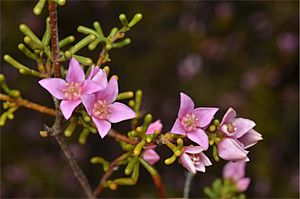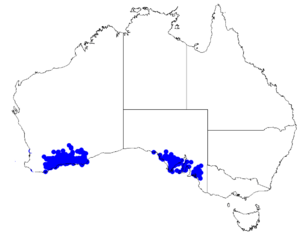Desert boronia facts for kids
Quick facts for kids Desert boronia |
|
|---|---|
 |
|
| Boronia inornata subsp. leptophylla in the Gawler Ranges | |
| Scientific classification | |
 |
|
| Occurrence data from Australasian Virtual Herbarium |
The Desert Boronia (Boronia inornata) is a special kind of plant. It belongs to the citrus family, called Rutaceae. This plant grows naturally only in southern Australia. It is a shrub that stands upright and has leaves with three parts. Its flowers can be pink, red, or white, and each flower has four petals.
Contents
What Does Desert Boronia Look Like?
Desert Boronia is a shrub that can grow either straight up or spread out. It usually reaches a height of about 0.2 to 1.2 meters (0.7 to 3.9 feet) tall. Its stems have small bumps, like warts, and are covered with short, soft hairs. These stems also have special glands.
The leaves of the Desert Boronia have three thick, smooth leaflets. Each leaflet is about 1.5 to 4 millimeters (0.06 to 0.16 inches) long.
The flowers are very pretty, coming in shades of pink, red, or white. They grow either by themselves or in small groups of two or three. You can find them where the leaves meet the stem (called leaf axils) or at the very tips of the branches.
Each flower has four rounded parts called sepals. These sepals are like small leaves that protect the flower bud. They are about 1.5 to 2 millimeters (0.06 to 0.08 inches) long and sometimes have hairs. The four petals are about 3 to 5 millimeters (0.12 to 0.20 inches) long.
Desert Boronia flowers from May to December. After flowering, it produces smooth fruits that are about 4 to 5 millimeters (0.16 to 0.20 inches) long.
How Was Desert Boronia Named?
The plant Boronia inornata was first officially described in 1852. This description was made by a scientist named Nikolai Turczaninow. He published his findings in a scientific paper called Bulletin de la Société Impériale des Naturalistes de Moscou.
The second part of its scientific name, inornata, comes from a Latin word. It means "unadorned" or "plain."
Different Types of Desert Boronia
There are two main types, or subspecies, of Desert Boronia:
- Boronia inornata subsp. inornata : This type has leaves that are covered in many hairs. Its sepals are also hairy, and the plant has a strong smell, like citrus fruit.
- Boronia inornata subsp. leptophylla : This type has smooth leaflets, sepals, and petals. It used to be known by a different name, Boronia clavellifolia.
Where Does Desert Boronia Grow?
Desert Boronia grows in different places. You can find it on rolling plains, on rocky hills, and near salt lakes.
The subspecies inornata only grows in Western Australia. It lives in a type of forest called mallee woodland. Sometimes, you can see many of these plants growing together, especially in areas where the soil has been disturbed or after bushfires.
Both subspecies grow in the Coolgardie, Esperance Plains, and Mallee regions of Western Australia. The subspecies leptophylla also grows widely in the southern part of South Australia.
Is Desert Boronia Endangered?
Good news! Both types of Desert Boronia (subspecies inornata and leptophylla) are considered "not threatened." This means they are not in danger of disappearing. The Western Australian Government's Department of Parks and Wildlife has classified them this way.

